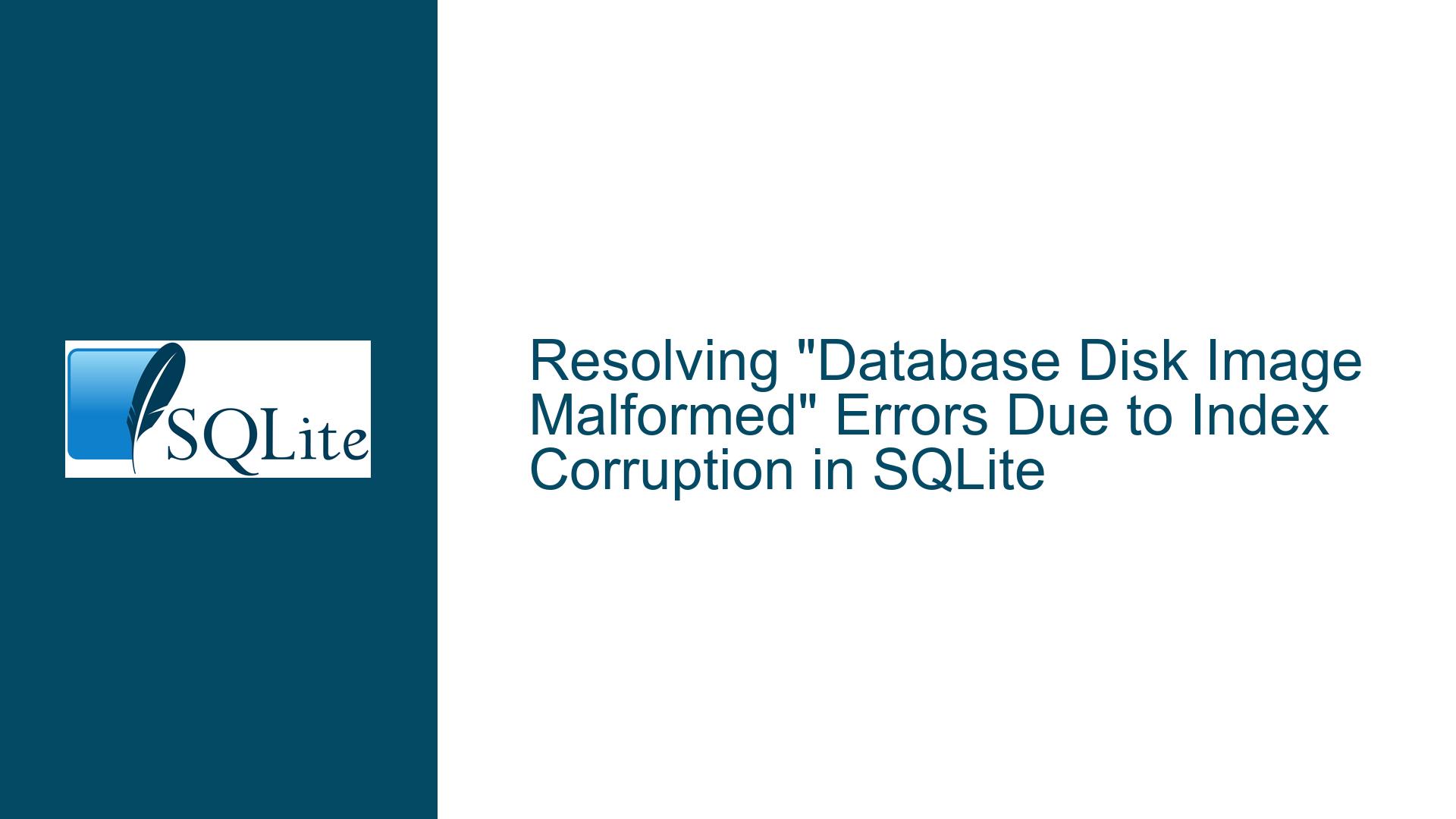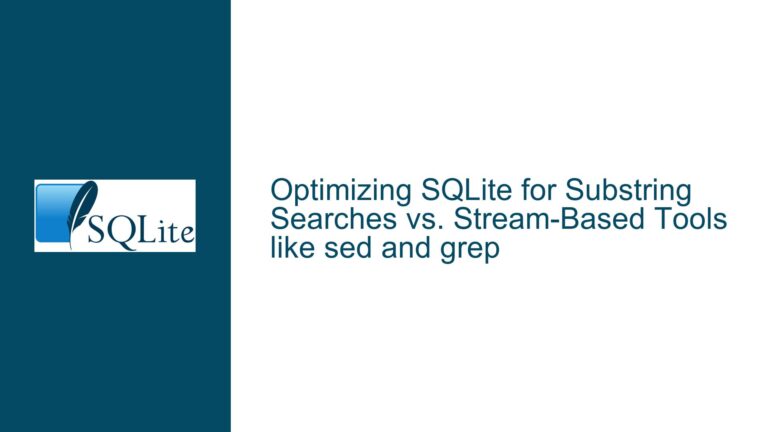Resolving “Database Disk Image Malformed” Errors Due to Index Corruption in SQLite
Diagnosing Index Corruption and Page Allocation Errors in SQLite Databases
Symptom Analysis: Integrity Check Failures and Malformed Disk Image Errors
The core issue involves SQLite databases returning "database disk image is malformed" errors when querying views, accompanied by integrity check results indicating missing index entries and unused pages. The integrity check output typically shows:
- Pages marked as "never used" (e.g., Page 372 in the example)
- Rows missing from specific indexes (e.g.,
raw_contact_sort_key1_index,raw_contact_sort_key2_index) - Successful recovery after
REINDEX, but intermittent recurrence under unknown conditions
This pattern points to index-tree corruption rather than table data corruption. SQLite uses B-tree structures for both tables and indexes. When indexes become inconsistent with their underlying tables, queries relying on those indexes (including views that reference indexed columns) will fail with malformed database errors. Unused pages suggest improper page allocation/deallocation during transactions, often due to interrupted write operations.
The Android/Linux environment adds complexity:
- Filesystem Behavior: SQLite relies on the OS’s file locking and synchronization primitives. On Android, file locking mechanisms vary across filesystems (e.g., F2FS, ext4), and improper
fsync()handling can leave index updates incomplete. - Concurrency Model: Multi-threaded write operations without proper synchronization (e.g., missing
BEGIN EXCLUSIVEtransactions) risk leaving index updates in a partially committed state. - Power Loss Scenarios: Sudden process termination or power loss during index rebuilds (e.g.,
REINDEX,VACUUM) can corrupt the page allocation map, leaving orphaned pages or incomplete index entries.
Root Causes: Why Indexes and Page Allocation Become Corrupted
1. Incomplete Write Operations Due to Improper Synchronization
SQLite’s durability guarantees depend on the PRAGMA synchronous setting and the filesystem’s adherence to flush requests. On Android, default settings like synchronous=NORMAL allow the OS to delay disk writes for performance. If the device loses power or the process is killed before pending writes complete, indexes may reference rows that were never committed or miss rows that were committed but not indexed.
2. Race Conditions in Multi-Threaded Environments
When multiple threads perform write operations without proper locking:
- Thread A begins updating a table and its indexes.
- Thread B reads the same index before Thread A commits, seeing inconsistent state.
- Thread B’s read operation forces SQLite to parse corrupted index pages, triggering malformed disk errors.
This is exacerbated by using WAL (Write-Ahead Logging) mode without busy_timeout, leading to SQLITE_BUSY errors that developers might mishandle.
3. Filesystem-Level Corruption
Android’s use of flash storage with wear-leveling algorithms can amplify write reordering. If the storage controller reorders writes to the database file and WAL/shared-memory files, SQLite’s recovery mechanisms may fail to reconstruct a consistent database state after a crash.
4. Index-Table Desynchronization During Bulk Operations
Operations like DELETE FROM table WHERE ... without subsequent ANALYZE or REINDEX can leave stale entries in indexes. Over time, these inconsistencies accumulate until a query triggers integrity checks.
Mitigation Strategies: Repairing and Preventing Index Corruption
Step 1: Immediate Recovery Using Built-in SQLite Tools
- Run
REINDEX: Rebuilds all corrupted indexes but does not address the root cause. - Export Data: Use
.dumpto export schema and data, then reimport into a new database:sqlite3 corrupted.db ".dump" | sqlite3 clean.db - Use
sqlite3_db_config()withSQLITE_DBCONFIG_RESET_DATABASE: Available in SQLite 3.21+, this resets the database without exporting data.
Step 2: Implement Robust Concurrency Controls
- Enforce Single-Writer Principle: Allow only one thread/process to modify the database at a time. Use
BEGIN EXCLUSIVEfor write transactions. - Enable WAL Mode with Caution:
PRAGMA journal_mode=WAL; PRAGMA wal_autocheckpoint=100; -- Aggressive checkpointingCombine with
PRAGMA busy_timeout=5000to handle concurrent reads.
Step 3: Strengthen Filesystem Synchronization
- Set
PRAGMA synchronous=FULL: Ensures all writes are flushed to disk before confirming transactions. - Disable File Locking Bypass: Avoid
PRAGMA locking_mode=NORMALon network filesystems or flash storage.
Step 4: Monitor and Repair Proactively
- Schedule Periodic Integrity Checks:
PRAGMA quick_check; -- Faster than integrity_check - Use
SQLITE_FCNTL_PERSIST_WAL: Prevents WAL file deletion on close, aiding forensic analysis after crashes.
Step 5: Address Android-Specific Risks
- Handle
onTrimMemory()Events: Close database connections when the OS signals low memory. - Test Under Battery Saver Mode: Simulate power constraints using Android’s
adb shell dumpsys battery unplug.
Step 6: Developer Best Practices
- Avoid
PRAGMA auto_vacuum=INCREMENTAL: Prevents partial vacuum operations that can leave indexes inconsistent. - Use
ATTACH DATABASEfor Bulk Operations: Isolate risky operations to a secondary database file.
By combining immediate recovery steps with concurrency controls, filesystem hardening, and proactive monitoring, developers can resolve "malformed disk image" errors and prevent recurrence.





